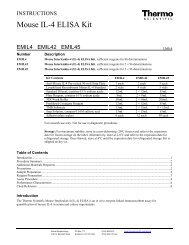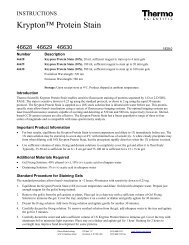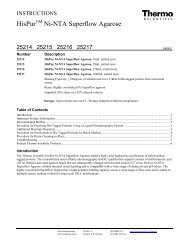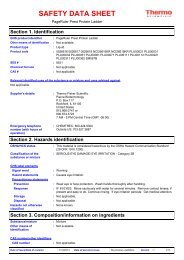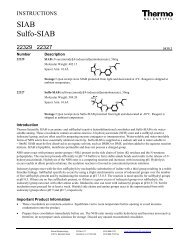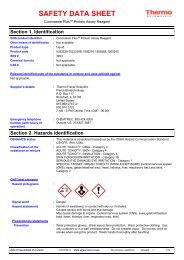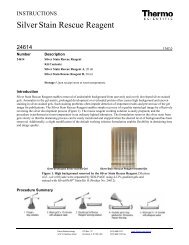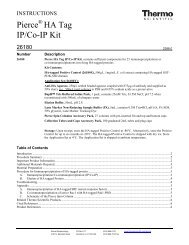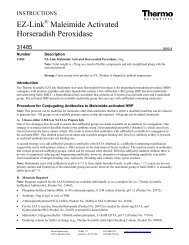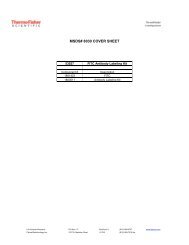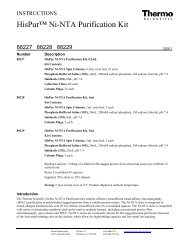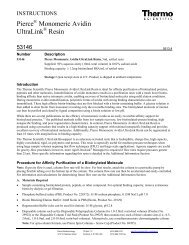Thermo Scientific Pierce Protein Assay Technical Handbook Version 2
Thermo Scientific Pierce Protein Assay Technical Handbook Version 2
Thermo Scientific Pierce Protein Assay Technical Handbook Version 2
You also want an ePaper? Increase the reach of your titles
YUMPU automatically turns print PDFs into web optimized ePapers that Google loves.
BCA-based <strong>Protein</strong> <strong>Assay</strong>s<br />
H 2 N<br />
H 2 N<br />
O<br />
180˚C<br />
NH 2<br />
O<br />
NH<br />
O<br />
+ NH 3<br />
Cu 2+<br />
NH 2<br />
O<br />
O<br />
O<br />
O<br />
NH 2<br />
NH<br />
NH 2<br />
NH 2<br />
NH<br />
NH 2<br />
Cu 2+<br />
H 2 N<br />
HN<br />
H 2 N<br />
H 2 N<br />
HN<br />
H 2 N<br />
O<br />
O<br />
O<br />
O<br />
Figure 2. Biuret reaction schematic.<br />
Urea Biuret Copper Complex<br />
In the second step of the color development reaction, BCA<br />
Reagent, a highly sensitive and selective colorimetric detection<br />
reagent reacts with the cuprous cation (Cu 1+ ) that was formed<br />
in step 1. The purple colored reaction product is formed by the<br />
chelation of two molecules of BCA Reagent with one cuprous<br />
ion (Figure 1). The BCA/Copper Complex is water-soluble and<br />
exhibits a strong linear absorbance at 562nm with increasing<br />
protein concentrations. The purple color may be measured at<br />
any wavelength between 550-570nm with minimal (less than<br />
10%) loss of signal. The BCA Reagent is approximately 100 times<br />
more sensitive (lower limit of detection) than the biuret reagent.<br />
The reaction that leads to BCA Color Formation as a result of the<br />
reduction of Cu 2+ is also strongly influenced by the presence of<br />
any of four amino acid residues (cysteine or cystine, tyrosine, and<br />
tryptophan) in the amino acid sequence of the protein. Unlike the<br />
Coomassie dye-binding methods that require a minimum mass of<br />
protein to be present for the dye to bind, the presence of only a<br />
single amino acid residue in the sample may result in the formation<br />
of a colored BCA-Cu 1+ Chelate. This is true for any of the four<br />
amino acids cited above. Studies performed with di- and tripeptides<br />
indicate that the total amount of color produced is greater<br />
than can be accounted for by the color produced with each BCA<br />
Reagent-reactive amino acid. Therefore, the peptide backbone<br />
must contribute to the reduction of copper as well.<br />
The rate of BCA Color Formation is dependent on the incubation<br />
temperature, the types of protein present in the sample and<br />
the relative amounts of reactive amino acids contained in the<br />
proteins. The recommended protocols do not result in end-point<br />
determinations, the incubation periods were chosen to yield<br />
maximal color response in a reasonable time frame.<br />
Advantages of the BCA <strong>Protein</strong> <strong>Assay</strong><br />
The primary advantage of the BCA <strong>Protein</strong> <strong>Assay</strong> is that most<br />
surfactants (even if present in the sample at concentrations up to<br />
5%) are compatible. The protein:protein variation in the amount<br />
of color produced with the BCA <strong>Protein</strong> <strong>Assay</strong> is relatively low,<br />
similar to that observed for the Modified Lowry <strong>Protein</strong> <strong>Assay</strong><br />
(Table 2, page 9).<br />
The BCA <strong>Protein</strong> <strong>Assay</strong> produces a linear response curve<br />
(r 2 > 0.95) and is available in two formulations based upon the<br />
dynamic range needed to detect the protein concentration of an<br />
unknown sample. The BCA <strong>Assay</strong> is less complicated to perform<br />
than the Lowry <strong>Protein</strong> <strong>Assay</strong> for both formulations. The standard<br />
BCA <strong>Protein</strong> <strong>Assay</strong> (Figure 3) detects protein concentrations<br />
from 20 to 2,000µg/mL and is provided with Reagent A (carbonate<br />
buffer containing BCA Reagent) and Reagent B (cupric sulfate<br />
solution). A working solution (WS) is prepared by mixing 50 parts<br />
of BCA Reagent A with 1 part of BCA Reagent B (50:1, Reagent<br />
A:B). The working solution is an apple green color that turns<br />
purple after 30 minutes at 37°C in the presence of protein. The<br />
ratio of sample to WS used is 1:20. The Micro BCA <strong>Protein</strong> <strong>Assay</strong><br />
(Figure 4) is more sensitive and has a narrower dynamic range of<br />
0.1-25µg/mL. To prepare the Micro BCA WS, three reagents (A,<br />
B and C) are mixed together at a ratio of 25 parts Micro Reagent<br />
A to 24 parts Micro Reagent B and 1 part Micro Reagent C. The<br />
Micro BCA WS is mixed with the sample or standard at a 1:1<br />
volume ratio. The purple color response is read at 562nm after<br />
1 hour at 60°C.<br />
Since the color reaction is not a true end-point reaction, considerable<br />
protocol flexibility is allowed with the BCA <strong>Protein</strong> <strong>Assay</strong>.<br />
By increasing the incubation temperature, the sensitivity of the<br />
assay can be increased. When using the enhanced tube protocol<br />
(incubating at 60°C for 30 minutes), the working range for<br />
the assay shifts to 5-250µg/mL and the minimum detection level<br />
becomes 5µg/mL.<br />
16<br />
For more information, or to download product instructions, visit www.thermoscientific.com/pierce



